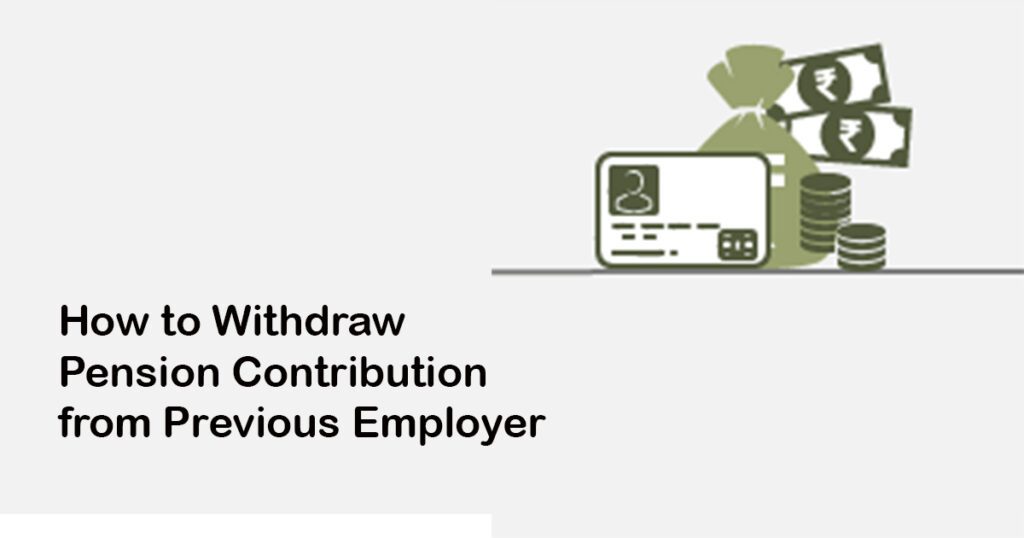Pension contributions are funds set aside by people or their employers solely for retirement-related expenses. These payments are typically withheld from an employee’s pay and put into a pension plan or similar investment vehicle. Pension contributions’ main goal is to build up savings over time, enabling people to ensure their financial security during their retirement years. Here are detail To withdraw pension contribution from a previous employer.

Depending on the kind of pension plan or scheme, pension contributions can take many different forms. In some cases, employers may set aside a specific portion of an employee’s pay for their pension, with the possibility for voluntary contributions from the employee as well. The tax benefits that may apply to these contributions, such as tax relief or deferral, depend on the jurisdiction and the particular pension regulations in place.
Gather Necessary Information
When gathering the information needed to withdraw your pension contribution from previous employer, follow these steps:
Contact your previous employer: Contact your former employer’s human resources or benefits department to inquire about the pension withdrawal process. They can provide useful advice and information regarding the steps required to start a withdrawal.
Know about the pension plan: Ask your former employer for a copy of the pension plan document. These documents provide important details about the terms and conditions of the scheme, eligibility requirements and withdrawal possibilities. Read the documents carefully to fully understand the specifics of your pension plan.
Find Pension Provider: Find out the name and details of the pension provider that will handle your contributions. Usually, pension plan documents contain this information, but your former employer may also be able to provide it.
Collect Personal Information: Collect personal data necessary for the withdrawal process. You may be required to provide your full name, address, Social Security number or other government-issued identification number, date of birth, and any other information specified by the pension provider or plan administrator.
Information about the employing organization: Be prepared to provide details about your previous employment, including dates of employment, positions held, and any required employment identification numbers or codes. The pension provider may need this information to assess your eligibility and handle your withdrawal request.
Find pension account information: Be sure to find and keep any account number or other identifying information related to your pension account. By providing this information, you can ensure that your account is identified correctly and communication with the pension provider is easy.
Identify the withdrawal criteria: Check the withdrawal guidelines provided by the pension provider or specified in the pension plan documents. Note any special paperwork, forms or other details required to initiate the withdrawal. Learn about any deadlines or schedules related to the withdrawal process.
Keep copies of all correspondence: Keep copies of all emails, letters and other correspondence you have with your former employer or pension provider. These records can help resolve any potential issues or discrepancies during the withdrawal process and will be useful for future reference.
Ask for clarification if necessary: If you have any questions or need additional clarification regarding the information required for withdrawal, do not hesitate to contact your former employer or pension provider directly. They can give you specific advice tailored to your circumstances.
Understand withdrawal options
A. Research pension withdrawal policies
It is important to research pension withdrawal policies to understand the specific rules and regulations To withdraw pension contribution from a previous employer. Here’s how you can research pension withdrawal policies:
Consult pension plan documents: Start by reviewing the pension plan documents provided by your previous employer or pension provider. These documents generally outline the terms and conditions relating to pension contributions and the options available for withdrawal. Pay close attention to the sections that discuss withdrawal eligibility, vesting periods, withdrawal penalties and any specific requirements or limitations.
Visit the website of the pension provider: Visit the website of the pension provider responsible for managing your contributions. Many pension providers provide detailed information about their withdrawal policies, including FAQs, guides and forms relating to the withdrawal process. Check the dedicated section on withdrawal options, eligibility criteria and required documents.
Contact the pension provider directly: Contact the pension provider’s customer care or support team to inquire about their specific withdrawal policies. Request information about available withdrawal options, any applicable fees or penalties, and the process for initiating a withdrawal. Be prepared to provide your personal details and account information to provide a more accurate response.
Research Government Regulations: Familiarize yourself with the relevant government regulations and laws governing pension withdrawals in your jurisdiction. Government websites, pension regulatory authorities or official publications often provide resources and guidance on pension-related matters. See information about withdrawal age requirements, tax implications, and any specific rules or exceptions that may apply to your situation.
Get professional advice: If you need more in-depth insight or guidance, consider consulting with a financial advisor, retirement planning specialist or pension specialist. These professionals can offer personalized advice based on your specific circumstances and help you navigate the complexities of pension withdrawal policies. They can also help you assess the impact of withdrawals on your overall retirement plan and help you make an informed decision.
Stay updated about changes: Keep yourself informed about any updates or changes in pension withdrawal policies. Rules and regulations relating to pensions may evolve over time and it is important to stay updated with the latest developments. To ensure your knowledge stays up to date, subscribe to relevant newsletters, follow official announcements or interact with professionals.
B. Set available withdrawal options
To determine to withdraw pension contribution from a previous employer follow these steps:
Review pension plan documents: View pension plan documents provided by your previous employer or pension provider. These documents outline the specific withdrawal options available to you. See the sections discussing withdrawal types, eligibility criteria, and any associated conditions or limitations.
Contact the pension provider: Contact the pension provider directly to know about the withdrawal options available. Contact their customer service or support team and provide them with your relevant personal information. Ask about the different withdrawal methods they offer, such as lump sum payments, annuity options or a combination of both.
Understand lumpsum withdrawals: If lumpsum withdrawals are an option, it means you can withdraw the full amount of your pension contributions as a single payment. Inquire about any fees, taxes or penalties associated with withdrawing a lump sum. Understand the potential impact on your overall retirement savings and consider consulting a financial advisor for guidance on effectively managing withdrawals.
Explore annuity options: An annuity is a regular stream of income that you receive from your pension contributions. Inquire about the annuity options available to you, such as a fixed annuity or an inflation-adjusted annuity. Understand the terms, frequency of payments and the potential for survivor benefits, if applicable. Consider whether an annuity fits your retirement income goals and financial needs.
Assess Partial Withdrawal Possibilities: Some pension plans may allow partial withdrawals, where you can withdraw a portion of your accumulated contributions and leave the balance invested. Inquire about partial withdrawal terms and limitations, such as minimum withdrawal amounts or frequency restrictions.
Consider rollover options: If you have a new employer with a pension plan or individual retirement account (IRA), ask about the possibility of rolling over your pension contributions. A rollover involves transferring funds directly to a new retirement account, potentially providing tax benefits and continuing investment opportunities.
Understand Tax Implications: Get a clear understanding of the tax implications associated with each withdrawal option. Depending on your jurisdiction and specific circumstances, different tax rules may apply to different withdrawal methods. Consult a tax professional or accountant to fully understand the potential tax consequences.
C. Consider tax implications and penalties
When considering To withdraw pension contribution from a previous employer, it is important to keep in mind the tax implications and potential penalties associated with withdrawals. Here are the key points to consider:
Consult a tax professional: Consult a tax professional or accountant who specializes in retirement planning. They can provide personalized guidance based on your specific circumstances and the tax laws in your jurisdiction.
Understand taxable income: Pension contributions withdrawn are generally considered taxable income. This means that the amount withdrawn by you may be subject to income tax at your applicable tax rate. The tax rate may vary depending on factors such as your gross income, filing status and local tax laws.
Early withdrawal penalty: In some cases, withdrawing pension contributions before reaching a certain age may attract an early withdrawal penalty. These penalties are imposed to discourage individuals from accessing retirement funds early. Familiarize yourself with the rules and penalties applicable to your pension plan or jurisdiction.
Consider rollover options: Instead of taking a direct withdrawal, you may have the option of rolling over your pension contributions to another retirement account, such as an Individual Retirement Account (IRA) or a new employer’s pension plan. Depending on the rules governing the new retirement account, a rollover can help you avoid taxes and potentially avoid penalties.
Evaluate a tax-efficient withdrawal strategy: Work with a tax professional to find a tax-efficient withdrawal strategy. For example, spreading withdrawals over several years or keeping withdrawals within certain income limits can help reduce your tax liability.
Check for exemptions or allowances: Some jurisdictions offer exemptions or allowances for certain types of pension withdrawals. Research whether there are certain circumstances, such as financial hardship, medical expenses, or first-time home buyer programs that may allow penalty-free or tax-advantaged withdrawals.
Understand state and local taxes: In addition to federal income taxes, be aware of any state or local taxes that may apply to your pension withdrawals. Tax rates and rules may vary from jurisdiction to jurisdiction, so consult a tax professional to understand the specific rules in your area.
Prepare Required Documentation
When preparing to withdraw your pension contribution from previous employer, it is important to gather the required documentation. Here’s a list of documents you may need:
Identification documents:
Valid government-issued identification: Prepare a copy of your passport, driver’s license, or national identity card. This document should include your photograph, full name, and date of birth.
Social Security number or equivalent: Provide your unique identification number issued by the government that is associated with your pension contributions and tax obligations.
Employment-related documents:
Employment contract or offer letter: Gather a copy of your employment contract or offer letter from your previous employer. These documents may contain information about your pension scheme, contributions, and withdrawal options.
Pay stubs or statements: Collect copies of your pay stubs or statements that show your pension contributions deducted from your salary. These documents can serve as proof of your contributions.
Pension-related documents:
Pension plan documents: Review the pension plan documents provided by your previous employer or the pension provider. These documents outline the terms and conditions of the pension scheme, including withdrawal procedures and eligibility requirements.
Annual benefit statements: If you received annual benefit statements from your previous employer or the pension provider, gather copies of these statements. They provide information about your accrued pension contributions and projected retirement benefits.
Bank account details:
Bank account information: Prepare your bank account details, including the account number and routing number, to facilitate the transfer of funds once the withdrawal is processed. This information is necessary for direct deposit or electronic fund transfers.
Contact information:
Current address and phone number: Ensure that your contact information is up to date. Provide your current residential address, phone number, and email address. This information will be used for communication regarding the withdrawal process.
Additional documents:
Power of attorney: If you are authorizing someone else to act on your behalf for the withdrawal, you may need to provide a power of attorney document.
Proof of marital status: In some cases, proof of marital status may be required, such as a marriage certificate or divorce decree, especially if you have a spouse or dependent who may be entitled to a survivor benefit.
Submit Withdrawal Request
To submit To withdraw pension contribution from a previous employer follow these steps:
Complete the withdrawal request form: Obtain the withdrawal request form from your previous employer or the pension provider. Fill out the form accurately and legibly, providing all the requested information. Be sure to double-check the form for any errors or missing information before submission.
Attach supporting documents: Gather all the required supporting documents as specified by the withdrawal request form or the pension provider. This may include identification documents, employment-related documents, pension plan documents, and any other documentation requested. Make sure to make copies of the documents and attach them securely to your withdrawal request.
Review the withdrawal terms and conditions: Carefully review the terms and conditions associated with the withdrawal, as outlined in the withdrawal request form or the pension plan documentation. Understand any fees, penalties, or tax implications that may apply to your withdrawal. If you have any questions or concerns, seek clarification from the pension provider before submitting the request.
Submit the withdrawal request: Once you have completed the withdrawal request form and gathered all the necessary supporting documents, submit the request to the appropriate party. This may involve mailing the form and documents to the pension provider’s designated address, submitting the request online through a secure portal, or following any other specified submission process. If required, keep a copy of the submitted documents for your records.
Follow up on the status of the request: After submitting the withdrawal request, it is advisable to follow up with the pension provider to confirm receipt and track the status of your request. Note any reference numbers or confirmation details provided by the pension provider for future reference. If there are any delays or issues, contact the pension provider’s customer service for assistance.
Monitor your bank account: If your withdrawal request is approved, monitor your bank account for the deposit of the withdrawn funds. Depending on the processing timeframes and the chosen withdrawal method, it may take some time for the funds to be transferred to your account. If there are any discrepancies or delays, promptly contact the pension provider to address the issue.
Track the Withdrawal Process
To withdraw pension contribution from a previous employer, follow these steps:
Note the submission date: Make a note of the date when you submitted your withdrawal request to the pension provider. This will serve as a reference point for tracking the progress of your request.
Retain confirmation details: If you received any confirmation or reference number upon submitting your withdrawal request, keep this information safe. It can be helpful when communicating with the pension provider regarding the status of your withdrawal.
Contact the pension provider: Reach out to the pension provider’s customer service or support team to inquire about the status of your withdrawal request. Provide them with any relevant details, such as your full name, identification number, and the submission date. Ask for an update on the progress of your request and if any additional information or actions are required from your end.
Follow up regularly: If you don’t receive a definitive answer or resolution during your initial contact, make a note to follow up with the pension provider regularly. Check with them at reasonable intervals to ensure that your request is being processed and to stay informed about any updates or issues that may arise.
Keep records of communication: Maintain a record of all communication with the pension provider regarding your withdrawal request. Note down the dates, names of the customer service representatives you speak with, and a summary of the discussions. This documentation can be valuable in case of any future disputes or discrepancies.
Seek escalation if necessary: If you encounter significant delays, encounter unresponsive customer service, or face any unresolved issues with the withdrawal process, consider escalating your concerns to a supervisor or manager within the pension provider’s organization. Request their assistance in expediting the processing of your withdrawal request or resolving any outstanding issues.
Be patient: Withdrawal processing times can vary depending on the pension provider, the complexity of your request, and any additional verification processes. While it is important to stay proactive and follow up on the progress, it is also crucial to remain patient during the process.
Receive and Manage the Funds
Once to withdraw pension contribution from a previous employer is approved and processed, you will receive the funds. Here’s what you should do to receive and manage the funds:
Confirm the receipt: Upon receiving the funds in your bank account or through the chosen payment method, confirm the receipt of the withdrawal amount. Check your bank statement or transaction history to ensure that the funds have been deposited correctly.
Verify the accuracy: Review the withdrawal amount to ensure it matches the expected amount based on your withdrawal request. If there are any discrepancies or if you believe an incorrect amount has been deposited, contact the pension provider’s customer service immediately to address the issue.
Account for tax obligations: Keep in mind that the withdrawn pension contributions may be subject to income tax. Consult with a tax professional to determine the tax liability associated with the withdrawal and ensure you account for it properly when managing the funds.
Assess your financial goals: Consider your financial goals and determine the best use for the withdrawn funds. Evaluate your immediate needs, such as outstanding debts, medical expenses, or essential expenses, and allocate the funds accordingly. If you have long-term financial goals, such as retirement savings or investment plans, consult with a financial advisor to explore suitable strategies.
Budget and plan wisely: Create a budget or financial plan to effectively manage the funds. Consider factors such as your current financial situation, future income sources, expenses, and savings goals. Prioritize necessary expenses and allocate funds for savings or investments to maximize the long-term benefit of the withdrawn amount.
Evaluate investment options: If you have surplus funds and wish to grow your savings, consider exploring investment options. Research different investment vehicles, such as stocks, bonds, mutual funds, or real estate, and seek advice from a financial professional to determine the most suitable investment strategy based on your risk tolerance and financial objectives.
Review retirement planning: If you withdrew your pension contributions before retirement, it is essential to revisit your retirement planning. Assess your overall retirement savings and explore alternative options to ensure you are on track to meet your retirement goals. Consider contributing to a new employer’s pension plan, opening an individual retirement account (IRA), or exploring other retirement savings vehicles.
Keep financial records: Maintain organized records of the withdrawal, including withdrawal confirmation, bank statements, tax documents, and any relevant correspondence with the pension provider or financial institutions. These records will be valuable for future reference, tax filing purposes, and tracking your financial progress.
Monitor your financial progress: Regularly review and monitor your financial progress after receiving the withdrawn funds. Track your expenses, savings, and investments to ensure you are making progress toward your financial goals. Adjust your financial plan as needed to accommodate any changes in your circumstances or goals.
Review Tax Obligations
Reviewing your tax obligations is an important step when to withdraw pension contribution from a previous employer. Here’s what you should do:
Understand taxable income: Withdrawn pension contributions are typically considered taxable income. This means that the amount you withdraw may be subject to income tax. Familiarize yourself with the tax laws and regulations in your jurisdiction to determine how pension withdrawals are taxed.
Consult a tax professional: It is highly recommended to consult with a tax professional or accountant who specializes in retirement planning and taxation. They can provide personalized advice based on your specific circumstances, help you understand your tax obligations, and guide you on how to report the pension withdrawal on your tax return.
Gather relevant documents: Collect all the necessary documentation related to the pension withdrawal, including withdrawal confirmation statements, tax forms provided by the pension provider, and any other supporting documents. These will be crucial when preparing your tax return and ensuring accurate reporting.
Determine tax rates: Understand the applicable tax rates based on your income level and filing status. Income tax rates can vary depending on your total income, deductions, and tax brackets. Refer to the tax laws and guidelines issued by your local tax authority to determine the appropriate tax rates for your pension withdrawal.
Consider tax deductions or credits: Explore if there are any tax deductions or credits available to you that can help reduce your tax liability. For example, some jurisdictions offer deductions for medical expenses or certain retirement contributions. Consult with your tax professional to identify any applicable deductions or credits and ensure you take full advantage of them.
Estimate tax liability: Use the information gathered and the guidance provided by your tax professional to estimate your tax liability resulting from the pension withdrawal. This will help you plan your finances and set aside funds to meet your tax obligations.
File your tax return: Prepare and file your tax return accurately and on time, including the necessary forms and schedules related to the pension withdrawal. Ensure that you report the withdrawn pension contributions and any associated taxable income correctly. If you are unsure about any aspect of your tax return, seek assistance from a tax professional or consider using tax preparation software.
Pay any taxes owed: If you have a tax liability resulting from the pension withdrawal, make sure to pay the taxes owed by the designated deadline. Failure to pay taxes on time may result in penalties and interest charges. Follow the guidelines provided by your local tax authority for making tax payments and explore available payment options.
Keep tax records: Maintain organized records of all tax-related documents, including your tax returns, withdrawal confirmations, and any correspondence with tax authorities. These records will be essential for future reference, audit purposes, and tracking your tax obligations over time.
Evaluate Investment Options
When evaluating investment options for your pension contributions, it’s important to consider your financial goals, risk tolerance, and time horizon. Here are some steps to guide you:
Determine your investment objectives: Clarify your investment goals. Are you looking for long-term growth, income generation, or capital preservation? Understanding your objectives will help guide your investment decisions.
Assess your risk tolerance: Evaluate your comfort level with investment risk. Consider factors such as your age, financial responsibilities, and investment knowledge. Generally, higher-risk investments offer greater potential returns but also come with increased volatility and potential losses. Determine your risk tolerance to select investments that align with your comfort level.
Research investment options: Explore a range of investment options available to you. These may include stocks, bonds, mutual funds, exchange-traded funds (ETFs), real estate, or other investment vehicles. Research the characteristics, historical performance, fees, and risks associated with each option to make informed decisions.
Diversify your portfolio: Spread your investments across different asset classes and sectors to mitigate risk. Diversification can help reduce the impact of any single investment’s performance on your overall portfolio. Consider a mix of investments that align with your risk tolerance and objectives.
Seek professional advice: Consider consulting with a financial advisor who can provide personalized guidance based on your specific circumstances. They can help assess your financial goals, risk tolerance, and recommend suitable investment options. A financial advisor can also provide ongoing portfolio management and monitor your investments.
Review investment performance: Examine the historical performance of potential investments to gauge their track record. Look at factors such as average returns, volatility, and risk-adjusted performance. However, keep in mind that past performance does not guarantee future results.
Evaluate fees and expenses: Assess the fees and expenses associated with each investment option. This includes management fees, transaction costs, and any other charges. Compare the costs across different investments to choose options that provide a good balance between performance potential and expenses.
Consider tax implications: Understand the tax implications of different investment options. Some investments may generate taxable income or have capital gains tax implications when sold. Consult with a tax professional to assess the tax efficiency of potential investments and minimize your tax liability.
Monitor and review your portfolio: Once you have selected investments, regularly monitor and review your portfolio’s performance. Keep track of market trends, economic indicators, and any changes in your financial situation. Adjust your investments as needed to align with your evolving goals and market conditions.
Stay informed and educated: Continuously educate yourself about investment strategies, market trends, and financial planning concepts. Stay updated on economic news and industry developments that may impact your investments. This knowledge will empower you to make informed decisions and adapt your investment strategy over time.
Conclusion
In conclusion, To withdraw pension contribution from a previous employer requires careful consideration and adherence to a systematic process. Throughout the process, seeking professional advice, such as consulting a tax professional or financial advisor, can provide valuable insights and ensure you make informed decisions. Remember to keep accurate records of all documents and communications related to the withdrawal.






